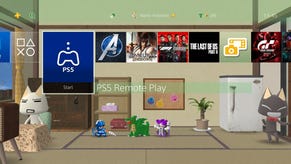Astro's Playroom on PS5: a brilliant introduction to the DualSense controller
Feel the difference.
Astro's Playroom arrives pre-installed on every PlayStation 5 and essentially serves as an introduction to Sony's new DualSense controller, brilliantly showcasing its resistive triggers and uncanny haptic feedback. Not only is the game a love letter to the PlayStation generation, it's a strong statement for Sony's vision for the future of gaming. We went into this one unsure of what to expect from the new controller, but it really is something genuinely exciting. In some respects, Astro's Playroom is the Wii Sports for PlayStation 5: the control system feels new and special and the game does a great job in selling the advantages to new PS5 owners.
The game itself is worthy of praise too - it may well be a free inclusion with every console, but this is no mere tutorial or demo: there's a real game here and it's a lot of fun. And beyond the remarkable feedback from the controller, the main aspect that really sticks out to me is the creativity on display. Making innovative use of the controller, Playroom really introduces a lot of neat mechanics and concepts into the mix that instantly helps you to understand what the DualSense brings to the table. The development team really is good at this - Astro Bot helped to introduce players to PSVR and eventually it received its own game, which is one of the best virtual reality experience ever made. Perhaps not surprisingly, the developer channels a lot of that work into this new game.
What's perhaps ironic about Astro's Playroom as a next generation showcase is that visually, this isn't a game that pushes boundaries - but it doesn't really matter. It's still a gorgeous game to behold, with a clean 4K output running at 60 frames per second with support for HDR. Beyond that, it's packed with little details around every corner: water that reacts and ripples as you move through it, physics-driven objects often litter your path, tumbling about as you run into them and all the little enemies and objects are supremely well crafted.
You'll also uncover some beautifully modelled peripherals from PlayStation's past - an EyeToy camera, for instance, with realistic plastic and even the little logos on the base. There's even an actual PlayStation 3 complete with a working card bay flap. Really, this ties into one of my favorite things about the game - all the callbacks to classic PlayStation hardware. At one point, you emerge to the sound of the PS3 booting up then, turn around, with the XMB filling the sky around you - it's a wonderful moment. In fact, the entire game is packed with fan service - it's a celebration of the entire PlayStation era.
But really, this is all about the DualSense controller. This new pad is bigger, weightier and feels more premium than its predecessor, but the next-gen factor comes down to the feedback. It starts with the adaptive triggers: essentially, the controller can apply variable levels of resistance to the triggers which change the feel and tension required to pull them. During Astro's Playroom, you jump into a 'spring suit' (for want of a better name), with the control system switching up accordingly. You pull the trigger to charge up and let go to spring away. The way these triggers can vary resistance so dramatically based on the currently performed action really surprised me. It has that same sense of force you might get from a force feedback steering wheel only applied to the triggers. This simple tension can have a huge impact on the feel of performing individual mechanics - in this case, you can 'feel' the potential energy in the coiled spring.
This is also paired with a return of a gyro feature - you use it to control certain mechanics in this game, just as it did in PS3 and PS4. However, it doesn't feel the same and that's because of another change - the new haptic rumble feature. So we've seen something like this with HD Rumble on Switch but quite frankly, this feels like a next-generation attempt at it. The level of precision and possible variations is simply unreal. Moving the controller around, the developers really give you the impression of a physical object rolling around inside the pad.
There are so many subtle vibrations and sensations that it's almost difficult to describe - you can genuinely feel the difference in Astro Bot's footsteps depending on the surface he's walking across. You can feel a difference when you jump into the water and swim around versus walking on land. When Astro gets caught in wet mud, you can feel the resistance as he pushes through. When it rains, you can feel the drops landing. This is all backed up by the controller's internal speaker: sound and sensation work together produce a remarkable effect.
And this is why Astro Bot is such a great match for the PS5. It plays beautifully and is imbued with the same level of creativity you expect from Asobi Team, but it also showcases each function of the controller in a fun way that immediately makes sense. It's the best introduction to a new system since Wii Sports, honestly - it has that same quality where it's both fun and immediately accessible while also showcasing what the system can do. Our preview of the game is limited to one level only and there is more to tell, but after playing this I really do hope that more users might go back to check out Astro Bot Rescue Mission on PlayStation VR. Without question, it's one of the best 3D platform games ever made.










